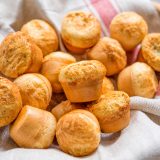We've eaten our share of gougères—light, airy French cheese puffs—and we're sure to have more. But Brazilian cheese puffs, pão de queijo, showed us something we hadn't realized we were missing: chew.
In Brazil, pão de queijo are eaten as a breakfast snack with coffee, as bar food and as sandwich bread. They're as cheesy, savory and addictive as gougères, with the same crispy exterior. But one bite reveals a toothsome, chewy interior that's slightly stretchy and rich—reminiscent of perfectly melted cheese.
The puff's unique texture is thanks to tapioca starch, the primary ingredient in pão de queijo and an essential ingredient in Brazilian cooking that turns up in crepes, flatbreads, and pastries sweet and savory.
Fine and powdery, tapioca starch contains 83 percent amylopectin–a long, branched starch molecule that gelatinizes and sets at low temperatures, giving the puff's their stable structure and satisfying chew.
Traditional recipes call for a stiff dough made and shaped by hand. For us, that produced dense puffs. Switching to a lighter, more fluid batter gave us lighter, puffier puffs. Even better, the batter comes together in a blender in just seconds.
Cheese presented a challenge. We thought a dry, hard cheese like Parmesan would result in a drier-textured puff, balancing the tapioca starch's stretchy texture. But puffs made with Parmesan were gummy. To our surprise, soft cheeses that melt well—Asiago, Gruyère, fontina—worked best in the batter.
Finally, we tried various methods of shaping. Hand-rolled puffs were impossible to form with our batter, so we tried muffin tins. That worked, but the ratio of crispy crust to soft, cheesy interior was off. The solution? A mini-muffin tin, which yielded perfectly shaped puffs with ease.
Our pão de queijo taste best after a short cooling, or at room temperature. But they also freeze well. Simply reheat the frozen puffs in a 350°F oven for 5 to 10 minutes.




